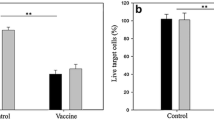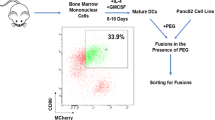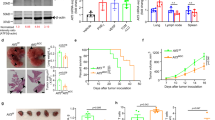Abstract
Background
Fms-like tyrosine kinase 3 receptor (Flt3) is an important receptor expressed on the cell membrane of immature antigen-presenting cells. The binding of Flt3 to its ligand (FL) activates the proliferation of dendritic cells (DCs). This mechanism is currently being evaluated in the therapy of malignant tumors. The aim of the present study was to study the effect of FL gene transfer on the immune response and tumor growth in experimental pancreatic cancer.
Materials and methods
The rat FL was sequenced and cloned from total mRNA extract of the spleen. Transfection efficiency of subcutaneously growing rat duct-like pancreatic cancer (DSL6A) with DOTAP-/cholesterol-based liposomes was tested using a pcDNA3.1-lacZ construct. Flt3 ligand production of in vitro transfected tumor cells and in vivo transfected tumors was measured by enzyme-linked immunosorbent assay. Tumor induction was achieved in Lewis rats by a subcutaneous inoculation of syngeneic pancreatic tumor cells (DSL6A). The animals were allocated into three groups: control, mock treatment, and treatment with FL plasmid. The plasmid was injected intratumorally three times per week for 2 weeks. The total observation time was 6 weeks.
Results
The tumor volume was significantly lower in the FL-transfected group during the first 3 weeks. The number of responders was significantly higher in the FL group compared with control and mock treatment. The number of CD80+ DCs in the spleen was significantly higher after FL gene transfer. The responders showed a significantly higher number of splenic natural killer (NK) cells. There were no differences of infiltrating lymphocytes, proliferation, and tumor blood vessels between the groups.
Conclusion
Intratumoral gene transfer of FL in rats activated proliferation of DCs and NK cells, which causes a moderate reduction of tumor growth. This improvement of local tumor control during the first weeks could be explained by an improved antigen presentation.





Similar content being viewed by others
References
Michaud DS (2004) Epidemiology of pancreatic cancer. Minerva Chir 59:99–111
Lim JE, Chien MW, Earle CC (2003) Prognostic factors following curative resection for pancreatic adenocarcinoma. Ann Surg 237:74–85
Neoptolemos JP, Stocken DD, Dunn JA, Almond J, Beger HG, Pederzoli P, Bassi C, Dervenis C, Fernandez Cruz L, Lacaine F, Buell MG, Dean DC, Adab FA, Sutton R, Imrie C, Ihse I, Tihanyi T, Olah A, Pedrazzoli S, Spooner D, Kerr DJ, Friess H, Buchler MW (2001) Influence of resection margins on survival for patients with pancreatic cancer treated by adjuvant chemoradiation and/or chemotherapy in the ESPAC-1 randomized controlled trial. Ann Surg 234:758–768
MacKenzie MJ (2004) Molecular therapy in pancreatic adenocarcinoma. Lancet Oncol 5:541–549
Picozzi VJ, Traverso LW (2004) The Virginia Mason approach to localized pancreatic cancer. Surg Oncol Clin N Am 13:663–674
Nukui Y, Picozzi VJ, Traverso LW (2000) Interferon-based adjuvant chemoradiation therapy improves survival after pancreaticoduodenectomy for pancreatic adenocarcinoma. Am J Surg 179:367–371
Guermonprez P, Valladeau J, Zitvogel L, Thery C, Amigorena S (2002) Antigen presentation and T cell stimulation by dendritic cells. Annu Rev Immunol 20:621–667
Pecher G, Haring A, Kaiser L, Thiel E (2002) Mucin gene (MUC1) transfected dendritic cells as vaccine: results of a phase I/II clinical trial. Cancer Immunol Immunother 51:669–673
Morse MA, Nair SK, Boczkowski D, Tyler D, Hurwitz HI, Proia A, Clay TM, Schlom J, Gilboa E, Lyerly HK (2002) The feasibility and safety of immunotherapy with dendritic cells loaded with CEA mRNA following neoadjuvant chemoradiotherapy and resection of pancreatic cancer. Int J Gastrointest Cancer 32:1–6
Gjertsen MK, Buanes T, Rosseland AR, Bakka A, Gladhaug I, Soreide O, Eriksen JA, Moller M, Baksaas I, Lothe RA, Saeterdal I, Gaudernack G (2001) Intradermal ras peptide vaccination with granulocyte-macrophage colony-stimulating factor as adjuvant: clinical and immunological responses in patients with pancreatic adenocarcinoma. Int J Cancer 92:441–450
Karsunky H, Merad M, Cozzio A, Weissman IL, Manz MG (2003) Flt3 ligand regulates dendritic cell development from Flt3+ lymphoid and myeloid-committed progenitors to Flt3+ dendritic cells in vivo. J Exp Med 198:305–313
Lyman SD, James L, Escobar S, Downey H, de Vries P, Brasel K, Stocking K, Beckmann MP, Copeland NG, Cleveland LS (1995) Identification of soluble and membrane-bound isoforms of the murine flt3 ligand generated by alternative splicing of mRNAs. Oncogene 10:149–157
Dong J, McPherson CM, Stambrook PJ (2002) Flt-3 ligand: a potent dendritic cell stimulator and novel antitumor agent. Cancer Biol Ther 1:486–489
Maraskovsky E, Brasel K, Teepe M, Roux ER, Lyman SD, Shortman K, McKenna HJ (1996) Dramatic increase in the numbers of functionally mature dendritic cells in Flt3 ligand-treated mice: multiple dendritic cell subpopulations identified. J Exp Med 184:1953–1962
Antonysamy MA, Thomson AW (2000) Flt3 ligand (FL) and its influence on immune reactivity. Cytokine 12:87–100
Lynch DH, Andreasen A, Maraskovsky E, Whitmore J, Miller RE, Schuh JC (1997) Flt3 ligand induces tumor regression and antitumor immune responses in vivo. Nat Med 3:625–631
Brasel K, McKenna HJ, Morrissey PJ, Charrier K, Morris AE, Lee CC, Williams DE, Lyman SD (1996) Hematologic effects of flt3 ligand in vivo in mice. Blood 88:2004–2012
Shaw SG, Maung AA, Steptoe RJ, Thomson AW, Vujanovic NL (1998) Expansion of functional NK cells in multiple tissue compartments of mice treated with Flt3-ligand: implications for anti-cancer and anti-viral therapy. J Immunol 161:2817–2824
Peron JM, Esche C, Subbotin VM, Maliszewski C, Lotze MT, Shurin MR (1998) FLT3-ligand administration inhibits liver metastases: role of NK cells. J Immunol 161:6164–6170
Silver DF, Hempling RE, Piver MS, Repasky EA (2000) Flt-3 ligand inhibits growth of human ovarian tumors engrafted in severe combined immunodeficient mice. Gynecol Oncol 77:377–382
Averbook BJ, Schuh JL, Papay R, Maliszewski C (2002) Antitumor effects of Flt3 ligand in transplanted murine tumor models. J Immunother 25:27–35
Furumoto K, Soares L, Engleman EG, Merad M (2004) Induction of potent antitumor immunity by in situ targeting of intratumoral DCs. J Clin Invest 113:774–783
Esche C, Subbotin VM, Maliszewski C, Lotze MT, Shurin MR (1998) FLT3 ligand administration inhibits tumor growth in murine melanoma and lymphoma. Cancer Res 58:380–383
Chen K, Braun S, Lyman S, Fan Y, Traycoff CM, Wiebke EA, Gaddy J, Sledge G, Broxmeyer HE, Cornetta K (1997) Antitumor activity and immunotherapeutic properties of Flt3-ligand in a murine breast cancer model. Cancer Res 57:3511–3516
Chakravarty PK, Alfieri A, Thomas EK, Beri V, Tanaka KE, Vikram B, Guha C (1999) Flt3-ligand administration after radiation therapy prolongs survival in a murine model of metastatic lung cancer. Cancer Res 59:6028–6032
Silver DF, Hempling RE, Piver MS, Repasky EA (2000) Flt-3 ligand inhibits growth of human ovarian tumors engrafted in severe combined immunodeficient mice. Gynecol Oncol 77:377–382
Ciavarra RP, Somers KD, Brown RR, Glass WF, Consolvo PJ, Wright GL, Schellhammer PF (2000) Flt3-ligand induces transient tumor regression in an ectopic treatment model of major histocompatibility complex-negative prostate cancer. Cancer Res 60:2081–2084
Ciavarra RP, Holterman DA, Brown RR, Mangiotti P, Yousefieh N, Wright GL Jr, Schellhammer PF, Glass WF, Somers KD (2004) Prostate tumor microenvironment alters immune cells and prevents long-term survival in an orthotopic mouse model following flt3-ligand/CD40-ligand immunotherapy. J Immunother 27:13–26
Ciavarra RP, Brown RR, Holterman DA, Garrett M, Glass WF 2nd, Wright GL Jr, Schellhammer PF, Somers KD (2003) Impact of the tumor microenvironment on host infiltrating cells and the efficacy of flt3-ligand combination immunotherapy evaluated in a treatment model of mouse prostate cancer. Cancer Immunol Immunother 52:535–545
Somers KD, Brown RR, Holterman DA, Yousefieh N, Glass WF, Wright GL Jr, Schellhammer PF, Qian J, Ciavarra RP (2003) Orthotopic treatment model of prostate cancer and metastasis in the immunocompetent mouse: efficacy of flt3 ligand immunotherapy. Int J Cancer 107:773–780
Favre-Felix N, Martin M, Maraskovsky E, Fromentin A, Moutet M, Solary E, Martin F, Bonnotte B (2000) Flt3 ligand lessens the growth of tumors obtained after colon cancer cell injection in rats but does not restore tumor-suppressed dendritic cell function. Int J Cancer 86:827–834
Borges L, Miller RE, Jones J, Ariail K, Whitmore J, Fanslow W, Lynch DH (1999) Synergistic action of fms-like tyrosine kinase 3 ligand and CD40 ligand in the induction of dendritic cells and generation of antitumor immunity in vivo. J Immunol 163:1289–1297
Chen K, Braun S, Lyman S, Fan Y, Traycoff CM, Wiebke EA, Gaddy J, Sledge G, Broxmeyer HE, Cornetta K (1997) Antitumor activity and immunotherapeutic properties of Flt3-ligand in a murine breast cancer model. Cancer Res 57:3511–3516
Miller G, Pillarisetty VG, Shah AB, Lahrs S, DeMatteo RP (2003) Murine Flt3 ligand expands distinct dendritic cells with both tolerogenic and immunogenic properties. J Immunol 170:3554–3564
Yanagi K, Nagayama Y, Nakao K, Saeki A, Matsumoto K, Ichikawa T, Ishikawa H, Hamasaki K, Ishii N, Eguchi K (2003) Immuno-gene therapy with adenoviruses expressing fms-like tyrosine kinase 3 ligand and CD40 ligand for mouse hepatoma cells in vivo. Int J Oncol 22:345–351
Dong J, Bohinski RJ, Li YQ, Van Waes C, Hendler F, Gleich L, Stambrook PJ (2003) Antitumor effect of secreted Flt3-ligand can act at distant tumor sites in a murine model of head and neck cancer. Cancer Gene Ther 10:96–104
Braun SE, Chen K, Blazar BR, Orchard PJ, Sledge G, Robertson MJ, Broxmeyer HE, Cornetta K (1999) Flt3 ligand antitumor activity in a murine breast cancer model: a comparison with granulocyte-macrophage colony-stimulating factor and a potential mechanism of action. Hum Gene Ther 10:2141–2151
Yang Q, Yang G, Wei L, Jia F, Wu M, Guo Y (2002) Gene transfer of murine Flt3 ligand mediated by adenoviral vector efficiently induces growth inhibition of murine liver cancer. Zhonghua Yi Xue Za Zhi 82:775–779
Cerundolo V, Hermans IF, Salio M (2004) Dendritic cells: a journey from laboratory to clinic. Nat Immunol 5:7–10
Dhodapkar MV, Steinman RM, Krasovsky J, Munz C, Bhardwaj N (2001) Antigen-specific inhibition of effector T cell function in humans after injection of immature dendritic cells. J Exp Med 193:233–238
Frohman MA, Dush MK, Martin GR (1988) Rapid production of full-length cDNAs from rare transcripts: amplification using a single gene-specific oligonucleotide primer. Proc Natl Acad Sci U S A 85:8998–9002
Pettengill OS, Faris RA, Bell RH Jr, Kuhlmann ET, Longnecker DS (1993) Derivation of ductlike cell lines from a transplantable acinar cell carcinoma of the rat pancreas. Am J Pathol 143:292–303
Ryschich E, Werner J, Gebhard MM, Klar E, Schmidt J (2003) Angiogenesis inhibition with TNP-470, 2-methoxyestradiol and paclitaxel in experimental pancreatic carcinoma. Pancreas 26:166–172
Lowry OH, Rosebrough NJ, Farr AL, Randall RJ (1951) Protein measurement with the Folin phenol reagent. J Biol Chem 193:265
Alsheikhly AR, Zweiri J, Walmesley AJ, Watson AJ, Christmas SE (2004) Both soluble and membrane-bound forms of Flt3 ligand enhance tumor immunity following “suicide” gene therapy in a murine colon carcinoma model. Cancer Immunol Immunother 53:946–954
Ito I, Ji L, Tanaka F, Saito Y, Gopalan B, Branch CD, Xu K, Atkinson EN, Bekele BN, Stephens LC, Minna JD, Roth JA, Ramesh R (2004) Liposomal vector mediated delivery of the 3p FUS1 gene demonstrates potent antitumor activity against human lung cancer in vivo. Cancer Gene Ther 11:733–739
Nomura T, Nakajima S, Kawabata K, Yamashita F, Takakura Y, Hashida M (1997) Intratumoral pharmacokinetics and in vivo gene expression of naked plasmid DNA and its cationic liposome complexes after direct gene transfer. Cancer Res 57:2681–2686
von Bernstorff W, Voss M, Freichel S, Schmid A, Vogel I, Johnk C, Henne Bruns D, Kremer B, Kalthoff H (2001) Systemic and local immunosuppression in pancreatic cancer patients. Clin Cancer Res 7(3 Suppl):925s–932s
Ryschich E, Noetzel T, Hinz U, Autschbach F, Ferguson D, Simon I, Weitz J, Froelich B, Klar E, Buchler MW, Schmidt J (2005) Control of T-cell mediated immune response by HLA class I in human pancreatic carcinoma. Clin Cancer Res 11:498–504
de Visser KE, Kast WM (1999) Effects of TGF-beta on the immune system: implications for cancer immunotherapy. Leukemia 13(8):1188–1199
Inaba K, Witmer-Pack M, Inaba M, Hathcock KS, Sakuta H, Azuma M, Yagita H, Okumura K, Linsley PS, Ikehara S (1994) The tissue distribution of the B7-2 costimulator in mice: abundant expression on dendritic cells in situ and during maturation in vitro. J Exp Med 180:1849–1860
Acknowledgements
We thank Ms. Claudia Bernardi and Ms. Irina Vöhringer for their excellent technical assistance.
Author information
Authors and Affiliations
Corresponding author
Additional information
The first two authors contributed equally to the work.
Rights and permissions
About this article
Cite this article
Ryschich, E., Huszty, G., Wentzensen, N. et al. Effect of Flt3 ligand gene transfer in experimental pancreatic cancer. Int J Colorectal Dis 22, 215–223 (2007). https://doi.org/10.1007/s00384-006-0118-5
Accepted:
Published:
Issue Date:
DOI: https://doi.org/10.1007/s00384-006-0118-5




